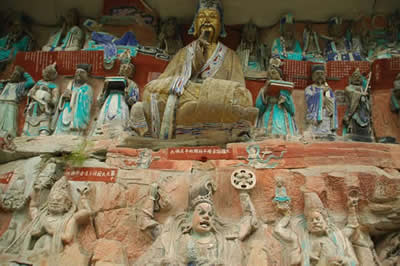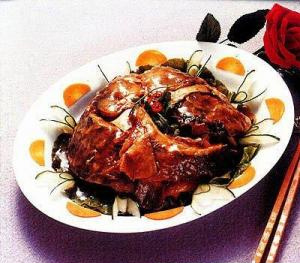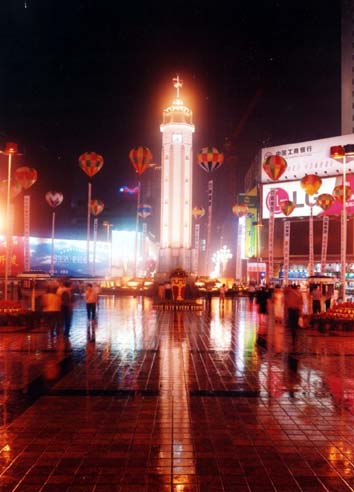Overview
 With a history of over 3,000 years, Chongqing, the birthplace of Ba and Yu
culture is one of the least well known but most important historical cities in
China.
With a history of over 3,000 years, Chongqing, the birthplace of Ba and Yu
culture is one of the least well known but most important historical cities in
China.
Today, little of this interesting past is visible and the city is
essentially an industrial mass.
Much of it is dirty and seedy but there is a lively atmosphere prevalent
about the place that often goes hand in hand with the more hardcore cities in
China.
The area known as Chongqing became the capital of the Ba State in the 11
century BC under the mythical King of the Yu. By the 12th Century AD, this small
city had grown in size and was renamed Chongqing, meaning Double happiness in
Chinese.
Despite the name, the city in fact has a rather turbulent past, and the
residents here have spent much of their history keeping invaders out. In 1242
Chongqing put up a defense against the Mongols and in 1937, the Kuomingtang fled
here from the Japanese.
The city withstood attack and was one of the last Kuomingtang bastions. In
1997, Chongqing separated from Sichuan to become an independent prefecture in
its own right. Today, this vast southwestern dynamo is known as Chongqing
Municipality.
Attractions

CiQiKou
Fourteen kilometers to the west of Chongqing Municipality lies the ancient
village of Ci Qi Kou (Porcelain Village) situated on the bank of the Jialing
River. It was recognized as a protected cultural site by the State Council in
1998. There are many shops lining the twelve flag stoned paved lanes that form
the main routes. Tourists will find many outlets for craftwork, groceries,
teashops and the like as well as a horologist, photography supplies, drugstore
and a tempting supply of roasted nuts and seeds.Chongqing attracts visitors from
home and abroad.

Dazu Rock Carvings
Carved during the ninth century, the rock carvings are un-missable works of
art of the Gold Buddhist Mountain, itself reputed as a rich repository of
diverse animal and plant species. Work on the Dazu Rock Carvings began in the
first year of Yonghui in the Tang Dynasty (650A.D.), and continued until the
Ming and Qing dynasties. Now, it is as popular as the Yungang and Longmen
Grottoes.
 General Joseph W.Stilwell Museum
General Joseph W.Stilwell Museum
General Joseph Warren Stilwell (1883-1946) was chief commander of US forces
in the China-Burma-India Theatre during World War II. In 1942, ranked as a major
general, he was dispatched to CBI and was regarded as the best field commander
in the entire United States Army. General Stilwell was a true friend of the
Chinese people as well as a Chinese linguist.
Yangte River Cruise

Yangtze River Cruise will be the highlight of your Chongqing tour. Upon
arrival at the Chaotianmen Port, you can see many ships on the river. Some of
them are used for cargo transportation; some are intended for the river cruise
passengers. The cruise ships provide three to eight days’ voyage. During the
trip, you can see the famous Three Gorges, Fengdu Ghost City, and Shennong
Stream and so on.
Dining
Chongqing dishes are rich in flavor and use almost 40 different cooking
methods in their preparation. Chongqing food is largely a hybrid of Sichuan
cuisine and local specialty dishes.
Chongqings city center is filled with restaurants and food stalls where
you can pick up a cheap and filling meal for less than RMB10. Local specialties
here include dumplings and pickled vegetables and, different from many other
Chinese cuisines, Chongqing dishes are ideal for the solo diner- arriving in
small individual sized portions!
This is where the HOTPOT originated and Chongqing residents are still very
keen on their native dish, tucking in even when the sun is shining.

Chongqing Hotpot
Chongqing hotpot is characterized by its spiciness! To suit customers of
different preference, salty and sweet/sour flavors of hot pot are available. As
long as you can stand the spiciness, you are advised to try the spiciest one to
ensure an authentic experience!
Jiangtuan fish
Since Chongqing is located along Jialing River, travelers have a good
opportunity to sample varieties of aquatic products. Among them, a local fish,
Jiangtuan fish, also called big-head fish, is probably the best.
The steamed fish, retaining all the essence, will definitely leave a deep
impression on anyone that has sampled it.

Pork leg cooked with rock candy
Pork leg cooked with rock candy is a common household dish of the Chongqing
people.
The finished dish, red in color and tender to taste ahs a strong and sweet
after-taste.
Sliced meat with crispy rice
Sliced meat with crispy rice is a major dish in Chongqing. The meat tastes
soft and tender while the rice is crispy, forming a sharp contrast with the
former.
When sampling this dish, you can even hear the sizzling sound emerging from
the rice.

Shopping
As a large metropolis, Chongqing boasts rich natural resources and local
specialties, making it a good place to do some shopping.
Due to the fact that Chongqing is a city surrounded by mountains, there are
many rare Chinese traditional herbal medicines in these parts including the
rhizome of Chinese goldthread (huanglian), Gastrodia elata (tianma) and the bark
of eucommia (duchong). Besides this, the fertile land here is ideal for the
friut growing, such as orange, pear, pomelo and persimmon.
Chongqing is also a major tea producing area. With a long history of
cultivation, Chongqing Tuo Tea, Cuiping Silver Needle Tea and Xinong Maojian Tea
enjoy high prestige both at home and abroad.
Gourmets have no right to feel disappointed when traveling in Chongqing:
Old Sichuan translucent beef slices, Peiling mustard tuber and Hechuan preserved
pear slices are all unusual things to try.
Folk handicraft in Chongqing has long been highly appraised. Since the
Southern Song Dynasty, Shu Embroidery (also known as Sichuan Embroidery) has
been ranked among the four most famous embroidery types in China, along with
Suzhou Embroidery, Hunan Embroidery and Cantonese Embroidery. Rongchang paper
fans are also exported and have been since the Qing dynasty.
Today, Jiefangbei is the central business district of the urban city and
the center of economic development of Chongqing Municipality. The Jiefangbei
commercial Pedestrian Street centers this well-known shopping area. Clusters of
modern shopping malls and exclusive shops line the roadsides. Banks, theatres,
KTV clubs, bookstores, hotels, bars and pubs are also quite easy to find. Some
of the main buildings worth seeing include Chongqing Department Store, New
Century Department Store, Commercial Mansion, Friendship Shopping Center,
Carrefour Supermarket and New Oriental Women Plaza.
The Chaotianmen Market, located on East Jiefang Road, is the biggest market
in Chongqing. Dealing primarily in Garment wholesale, it is reported that goods
traded in the market come from or are sold to more than 200 counties in Sichuan,
Hubei and Hunan provinces. Shoppers can expect to find stylish clothes and very
reasonable prices. Still, bargaining with the vendors in most stalls and shops
will ensure a great deal!
Nan Bin Road boasts a newly opened flower market that has become a leisure
hotspot for locals and tourists. Over 100 flower shops, handicrafts stores and
tea houses line both sides of the street. Flower houses in European and
traditional Chinese styles provide a picturesque setting for enjoying the
vibrant colors and scents of the merchants offerings that await you. In
addition to the various kinds of blossoms, you can also find many delicate
potted plants. Located at the entrance of Huang Ge Du Park, Nan Bin Flower
Market is a great place to unwind day or night.